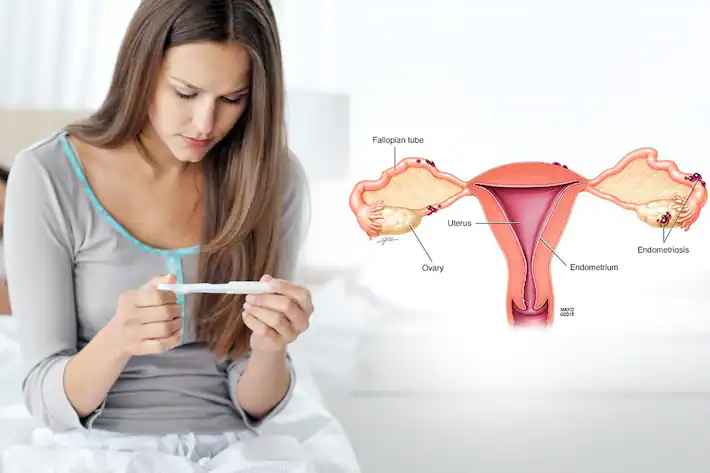A wide spectrum of reasons contribute to fertility problems in men and women. This article focuses on endometriosis and tubal blockages, among infertility causes in women. Almost 5-20% of reproductive-aged women are battling endometriosis, resulting in the blockage of tubules, and nearly 30-40% of women with endometriosis have problems conceiving.
The fallopian tubes of the female reproductive tract are the connecting bridges between the uterus and ovaries essential for movement and fertilization of the egg/ovum with sperm. When the fallopian tubes get blocked, the movement of gametes is restricted, the fusion of gametes becomes difficult, and so does the possibility of a successful pregnancy.
The painful adhesions of the endometrial lining caused by endometriosis can impact the fallopian tubes, damage and block them, leading to tubal endometriosis, making it difficult for women to conceive.
Here, we shall discuss the various treatment modalities for fallopian tube blockages caused by endometrial growths and the chances of getting pregnant after unblocking the fallopian tubes.
Also Read: Women with Undiagnosed Endometriosis Face Difficulty in Getting Pregnant, Research Says
In this Article
How Endometriosis Causes Fallopian Tube Blockage?
Endometriosis is when the endometrial lining of the uterus grows beyond the limits of the uterine walls affecting the fallopian tubes, ovaries, and other pelvic organs. Most women with mild or moderate endometriosis do not face difficulty getting pregnant. However, as and when the severity or growth of endometrial tissues increases, the complications of this disease increases.
In endometriosis, the endometrial tissues grow even in the inner areas of the pelvic organs, such as the area under the ovaries, behind the uterus, bowels, bladders, etc.
During menstruation, the uterine lining swells, breaks, bleeds, and so do these outgrown endometrial tissues. This highly irritating inflammation and painful condition lead to various complications within the pelvic region, such as
- Scar tissue formations in the pelvic region accumulating over several painful menstruations to block the ovarian function and the fallopian tubes.
- Endometrial cysts occur when repetitive bleeding of the endometrial tissues results in the collection of thick dark blood/fluid in the ovaries. Also known as ‘chocolate cysts’ eventually increases scarring and fallopian tube blockage.
- Pelvic adhesions or adhering of the tissues and organs of the pelvis like the intestines, ovaries, and tubes are caused by weed-like endometrial growths spread in the pelvic region, leading to blockage of tubal functions.
Endometriosis may cause inflammation and damage the fallopian tubes, ovaries, and other pelvic organs. These blockages restrict the passage of sperm and egg and damage them.
Other reasons for a blocked fallopian tube can be the infectious damage and scarring by sexually transmitted diseases (STDs) or Pelvic Inflammatory Diseases (PID). A treatment for endometriosis, infections, or unblocking the fallopian tube is required to promote pregnancy possibilities.
Treatment for Blocked Fallopian Tubes and Endometriosis
During the menstrual cycle, when the ovaries release the egg, it travels down the fallopian tube and waits for the sperm to fertilize. The sperm released into the female reproductive tract travels up to the egg to fertilize in the fallopian tubes. Interestingly, even one functional fallopian tube (of the two fragile tubes) is sufficient for a successful pregnancy or fertilization to occur. The problem arises when both the fallopian tubes get clogged or damaged.
Evaluation of the extent of blockage is required and done by a specialized dye-based X-ray called Hysterosalpingography (HSG) and laparoscopy.
Laparoscopic surgery, a minimally invasive technique, is an effective fallopian tube blockage treatment. Here, a small incision made in the lower abdominal regions allows necessary instruments along with a laparoscope (a flexible tube-like device with a camera and light at one end) to aid a clear view of the internal blockage and eliminate it sequentially. Below described are some of the commonly performed laparoscopic fallopian tube surgeries.
| Fallopian Tube Surgery | How and why is it done? |
| Salpingectomy |
|
| Laparoscopic Tubal Reanastomosis |
|
| Fimbrioplasty |
|
| Selective Tubal Cannulation |
|
Possible treatments for endometriosis are listed below.
| Treatment methods | How is it performed? |
| Laparoscopic ablation |
|
| Tubal flushing with oil-soluble medium |
|
Chances of getting pregnant after unblocking
Every surgical procedure requires a certain recovery period. However, the laparoscopy for the blocked fallopian tubes recovery time is less than a week. A surgical unblocking of fallopian tubes allows free movement of gametes, and the pregnancy chances improve invariably. However, not to rule out the blockage region or damage and factors such as scar tissue build-up, infections, adhesions, and other diseases that decide the success of surgery and pregnancy.
- A successful conception is more likely when the fallopian tube blockage is near the proximal end or near the uterus than the ovarian end of the fallopian tube.
- Approximately 60% of women with fallopian tube blockage near the uterus have had a successful pregnancy after a fallopian tube surgery.
Conclusion/ Take-Away
Rarely does endometriosis interfere in getting pregnant, and seldom does a fallopian tube block show symptoms. But, a blockage of fallopian tubes due to endometriosis or infections can certainly cause severe abdominal cramping, heavy menstruation, and fertility problems. However, a laparoscopy for blocked fallopian tubes can improve the chances of a successful conception. Even when chances post-surgery seem bleak, assisted reproduction via IVF can help have a child. Contact a fertility specialist if you have severe stomach cramps, heavy menstruation, or issues in conceiving.
References:
Overview Endometriosis | https://www.mayoclinic.org/diseases-conditions/endometriosis/diagnosis-treatment/drc-20354661
Overview Blocked Fallopian tube | https://www.healthline.com/health/womens-health/blocked-fallopian-tubes#pregnancy
https://www.uofmhealth.org/health-library/hw203637
This content has been reviewed by Srujana Mohanty who is working in scientific & medical writing and editing since 2018. She is also associated with the quality assurance team of scientific journal editing.



